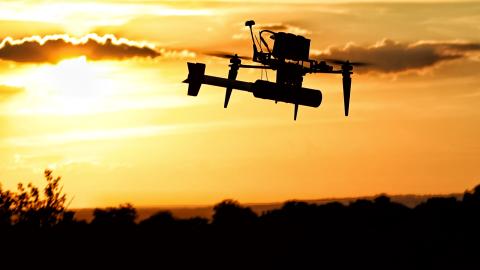Below Senior Fellow Can Kasapoğlu offers a military situation report about the war in Ukraine.
Executive Summary
- The Russian military pressed to capture logistically important routes in eastern Ukraine.
- Ukraine continued to launch long-range strikes and first-person-view drone attacks on targets in Russia and occupied Ukrainian territory.
- Belarus demonstrated that it is developing and deploying a variant of the Iranian Shahed-136 loitering munition.
- Despite some positive developments, the North Atlantic Treaty Organization’s Washington summit did not achieve the decisive action Kyiv hoped for.
1. Battlefield Assessment
Last week, Russian combat formations advanced in several locations in eastern Ukraine, most notably in the direction of the city of Pokrovsk. Russian forces also registered tactically significant territorial gains, including the capture of the long-contested town of Yasnobrodivka, although the Ukrainian General Staff denies the town has fallen and reports that fighting there is ongoing.
Alarmingly, Russian forces also made progress in their efforts to capture critical infrastructure and logistics arteries along the road that connects Kostiantynivka and Pokrovsk. This push threatens already outgunned Ukrainian defensive combat operations in the town of Chasiv Yar, a vital position to which both sides have dedicated considerable resources.
Meanwhile, the Kremlin continued to drop glide bombs on Ukraine’s population centers, a menacing tactic that Kyiv can only address by targeting the airbases deep inside Russia from which the strike packages originate. But the Kremlin’s overall gains come with a heavy price tag: according to several assessments, the Russian death toll has been skyrocketing. Some sources have suggested that Russian losses have roughly doubled since 2023.
In southern Ukraine, elements from Russia’s most capable main units, including the 58th Combined Arms Army (CAA), the 7th Airborne Forces (VDV) Division, and the 22nd Spetsnaz Brigade, maintained pressure on Ukrainian forces. Unlike in Ukraine’s east, however, Russia did not secure any significant territorial gains in its southern advance.
Meanwhile, Ukrainian forces continued to strike critical Russian assets. A video circulated by the Ukrainian Defense Ministry suggested that Kyiv’s first-person-view (FPV) drones reportedly struck and destroyed a Russian TOS-1 heavy flamethrower system around Pokrovsk in Donetsk Oblast. Demonstrating their continued prowess in deep-strike missions, Ukrainian forces also hit a Russian oil depot in Kalach-na-Donu some 250 miles from the front lines. Moreover, Ukraine recently launched a missile attack on a large ammunition depot in Voronezh, struck the Russian-controlled Mariupol International Airport, and hit targets in occupied Crimea.
2. Belarus Showcases Iran’s Drone Warfare Systems
At a parade last week in Minsk, the Belarusian Armed Forces showed off loitering munitions based on the Iranian Shahed-136, a baseline known in Russia as the Geran-2. Belarusian President Aleksandr Lukashenko’s regime has further rebranded the kamikaze drone, dubbing it Kochyovnyk, or “nomad.”
Social media reports suggest that the Belarusian drone features nearly the same warhead configuration and range as Russian and Iranian versions, showcasing a deepening defense-industrial partnership between Moscow and Minsk. The drones also suggest significant Iranian involvement in Belarus.
In December 2022, the Iranian ambassador to Belarus stressed the need for increased cooperation between Tehran and Minsk to counter Europe and the United States. In the summer of 2023, the two parties signed an extensive memorandum of understanding on military cooperation that reportedly committed Belarus to supporting Iran in its production of Shahed loitering munitions. Reports further suggest that a delegation of Iranian engineers also inspected several sites in Belarus, such as Gomel, to convert factories to drone production plants. Recent statements by the Iranian press suggest that Tehran and Minsk share “common views” on important regional and global issues and are ready to support each other. Officials from Iran’s Islamic Revolutionary Guard Corps (IRGC) have also visited Belarus to help Russian combat formations launch kamikaze drone attacks from Belarusian territory.
With the recent pro-Russian reshuffle in the Belarusian military’s command and Moscow’s deployment of tactical nuclear weapons to the country, Belarus is rapidly becoming a vassal of the Kremlin. Previous editions of this report have highlighted that the joint Russia-Iran drone plant in Russian Tatarstan could serve as a model for similar facilities that could spring up across the Russian Federation. The US and its allies need to watch Belarus closely for any further Iranian and Russian activity, as the country provides potentially fertile ground for Iranian drone warfare efforts.
3. The NATO Summit Offers Kyiv a Glimpse of Hope, but No Decisive Action
Focusing on the critical issues of transatlantic defense-industrial cooperation, defense spending, air defense, terrorism, and nuclear deterrence, the North Atlantic Treaty Organization’s Washington summit communiqué reflects the pressing security situation in Ukraine and the alliance’s military shortfalls. The press release highlighted several specific measures designed to support Kyiv against the unfolding Russian invasion, including the appointment of a NATO senior representative to Ukraine and the establishment of the NATO-Ukraine Joint Analysis, Training, and Education Centre (JATEC), a significant initiative that will boost interoperability and cooperation between Ukraine and NATO.
Several allies also announced important military aid at the summit. The United States stated that F-16 fighter jets will soon arrive in Kyiv, although the exact dates of delivery remain unclear. Officials from Denmark and the Netherlands also confirmed this rough timeline.
Other important breakthroughs came in the realm of defense-industrial production. Northrop Grumman announced a plan to coproduce medium-caliber ammunition in Ukraine with its local counterparts. South Korea also announced that it will double its contributions to the alliance’s Ukraine fund.
Despite these pledges, strong political messaging, and several other promising decisions, the NATO summit failed to achieve a critical milestone. The communiqué framed Ukraine’s accession process as an “irreversible” yet continuing journey, but did not extend Kyiv an official invitation to join NATO.
Meanwhile, Russia continued to deepen its existing partnerships, particularly with North Korea. As numerous reports confirmed, last week marked the first visit of a North Korean elite military training delegation to Russia since Moscow and Pyongyang signed a military-strategic cooperation agreement in June 2024. This visit is another example of the growing cooperation between the two countries.


















